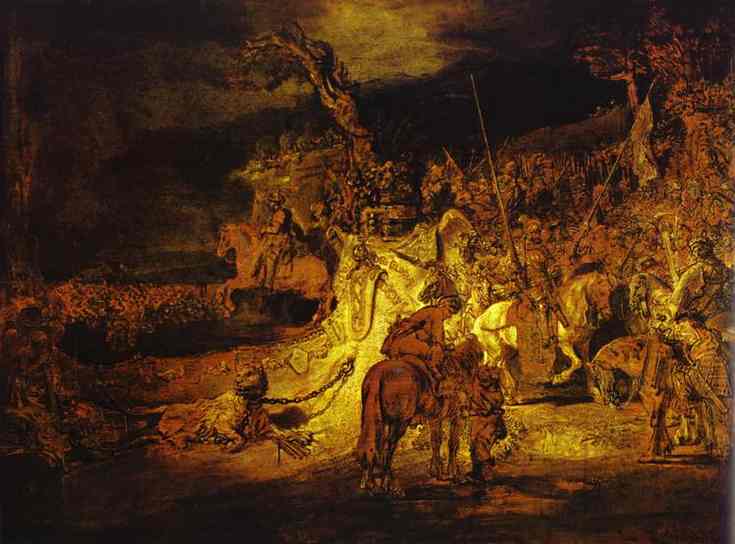Description
The work "Unity (Agreement) in the Country", painted by Rembrandt in 1641, is part of his prolific production during the Dutch Golden Age, a period characterized by great artistic and cultural effervescence. This painting, although less known than others by its author, reveals Rembrandt's mastery in the representation of human interaction and the complexity of social relations, recurring themes in his work.
The painting shows a group of people gathered outdoors, in a natural setting that suggests an atmosphere of coexistence and dialogue. In the centre of the composition, two figures stand out, probably representing leaders or mediators in an agreement, evidencing their importance in the context portrayed. The arrangement of the characters creates a circular movement that invites the viewer to participate in the scene, suggesting a sense of unity and cohesion between them.
The use of light and shadow, a technique that has become emblematic of Rembrandt's work, lends depth and volume to the figures. The light that bathes the characters' faces focuses attention on their expressions, which reflect various emotional states that can be interpreted as hope and collaboration. This mastery of chiaroscuro, which Rembrandt perfected throughout his career, highlights not only the physicality of the subjects, but also the richness of the interaction between them, elevating the narrative of the work to an almost theatrical level.
Colour plays a crucial role in this painting, where a palette of earthy tones predominates, with subtle nuances that bring warmth and character to the landscape. This colour choice not only places the characters in a natural context, but also suggests an intrinsic connection between humans and their environment, a recurring theme in the artist's work. The breeze that seems to move the landscape and the characters' clothes adds a sense of movement and vitality to the work.
Stylistically, "The Unity (Agreement) in the Country" is a reflection of Rembrandt's penchant for moments of gathering that evoke everyday life, similar to his other works in which human interaction is central. It reminds us of his famous "Dr. Tulip's Anatomy Lesson," where considerable emphasis is also placed on the relationships between the characters and the context of their surroundings.
Importantly, although the work may not be as iconic as his better-known portraits, studying it reveals fascinating aspects of Rembrandt’s versatility as a visual storyteller. In this sense, the painting becomes a testament to the artist’s interest in human conflict and the search for consensus in a world that, then as now, is rife with tension and division.
This painting is set in a time when the Netherlands was in a state of social and political transformation, which can be interpreted as an echo of the realities of his time. Through this painting, Rembrandt not only shows his technical and artistic skill, but also his deep understanding of human nature and his desire to represent unity and agreement, symbolizing a hope for peace and collaboration in a fractured world. Thus, “Unity (Agreement) In The Country” becomes a visual testimony that challenges the viewer to reflect on the importance of social cohesion and mutual understanding, a message that resonates just as strongly in our days.
KUADROS ©, a famous painting on your wall.
Hand-made oil painting reproductions, with the quality of professional artists and the distinctive seal of KUADROS ©.
Painting reproduction service with satisfaction guarantee. If you are not completely satisfied with the replica of your painting, we will refund 100% of your money.

